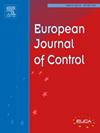基于多连接递归神经网络的四旋翼无人机超扭转终端滑模控制
IF 2.6
3区 计算机科学
Q2 AUTOMATION & CONTROL SYSTEMS
引用次数: 0
摘要
考虑到四旋翼无人机(UAV)执行任务时所处的复杂环境,建立准确的无人机模型和获取外界干扰信息是一项困难的工作。针对上述问题,提出了一种基于超扭转算法(STA)的多连接递归神经网络(MCRNN)终端滑模控制(TSMC)策略。由于系统动力学未知,滑模控制的等效控制律不能直接应用于无人机。因此,采用MCRNN控制器来近似等效控制而不是估计四旋翼无人机的动力学。在MCRNN中,所有隐藏层神经元都能接收自反馈和来自其他隐藏层神经元的信号,从而增强了它们捕捉复杂动态特征的能力。此外,利用滑模的鲁棒性来抑制不匹配干扰,取代传统的干扰观测器。这种解决方案更加灵活,并且降低了计算成本。利用李雅普诺夫稳定性理论保证了整个系统的有限时间稳定性,推导了MCRNN权值的实时更新规律。最后,将该方法应用于路径跟踪任务,最大超调量为4.58e−02,沉降时间为0.935s。通过对比不同方法得到的结果,表明所设计的控制器对模型参数变化不敏感,能够抑制失匹配干扰,具有较好的稳定性和鲁棒性。本文章由计算机程序翻译,如有差异,请以英文原文为准。
A multiple connected recurrent neural network based super-twisting terminal sliding mode control for quad-rotor UAV
Considering the complex environment in which quad-rotor unmanned aerial vehicle (UAV) perform their tasks, it is difficult to establish an accurate UAV model and obtain information about external disturbances. Aiming at the above problems, a multiple connected recurrent neural network (MCRNN) based on super-twisting algorithm (STA) terminal sliding mode control (TSMC) strategy is proposed. Due to the unknown dynamics, the equivalent control law of sliding mode control cannot be directly applied to UAVs. Therefore, the MCRNN controller is used to approximate the equivalent control rather than to estimate the dynamics of the quad-rotor UAV. All hidden layer neurons in MCRNN receive self-feedback as well as signals from other hidden layer neurons, thereby augmenting their capacity to capture intricate dynamic features. In addition, the robustness of the sliding mode is used to suppress the mismatched disturbance instead of the traditional disturbance observer. This solution is more flexible, and reduces computing costs. Lyapunov stability theory is used to ensure the finite-time stability of the whole system, and the real-time update law of MCRNN weights is derived. Finally, the proposed method is applied to a path-following task, obtaining a maximum overshoot of 4.58e−02 and the settling time of 0.935s. By comparing the results obtained by different methods, it is concluded that the proposed controller is insensitive to model parameter variations, is able to suppress mismatched disturbances, and has significant stability and robustness.
求助全文
通过发布文献求助,成功后即可免费获取论文全文。
去求助
来源期刊

European Journal of Control
工程技术-自动化与控制系统
CiteScore
5.80
自引率
5.90%
发文量
131
审稿时长
1 months
期刊介绍:
The European Control Association (EUCA) has among its objectives to promote the development of the discipline. Apart from the European Control Conferences, the European Journal of Control is the Association''s main channel for the dissemination of important contributions in the field.
The aim of the Journal is to publish high quality papers on the theory and practice of control and systems engineering.
The scope of the Journal will be wide and cover all aspects of the discipline including methodologies, techniques and applications.
Research in control and systems engineering is necessary to develop new concepts and tools which enhance our understanding and improve our ability to design and implement high performance control systems. Submitted papers should stress the practical motivations and relevance of their results.
The design and implementation of a successful control system requires the use of a range of techniques:
Modelling
Robustness Analysis
Identification
Optimization
Control Law Design
Numerical analysis
Fault Detection, and so on.
 求助内容:
求助内容: 应助结果提醒方式:
应助结果提醒方式:


